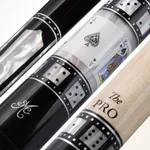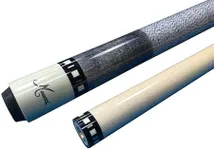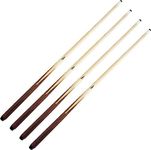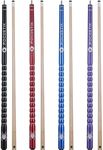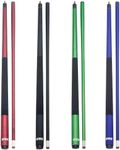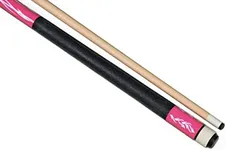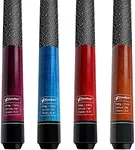Buying Guide for the Best Cues Sticks
Choosing the right cue stick is essential for improving your game and ensuring a comfortable playing experience. Whether you're a beginner or an experienced player, understanding the key specifications of cue sticks will help you make an informed decision. Here are the main factors to consider when selecting a cue stick that best fits your needs.WeightThe weight of a cue stick is crucial because it affects your control and the power of your shots. Cue sticks typically range from 17 to 21 ounces. Lighter cues (17-18 ounces) are easier to control and are often preferred by players who focus on finesse and precision. Medium-weight cues (19-20 ounces) offer a balance between control and power, making them a popular choice for many players. Heavier cues (21 ounces) provide more power and are suitable for breaking shots or players who prefer a more forceful game. Choose a weight that feels comfortable in your hand and matches your playing style.
LengthCue sticks generally come in lengths ranging from 48 to 58 inches. The standard length for most adult players is 57-58 inches. Shorter cues (48-52 inches) are ideal for younger players or those with a smaller stature, as they are easier to handle. They are also useful in tight spaces where a full-length cue might be cumbersome. Standard-length cues (57-58 inches) are suitable for most adult players and provide a good balance of reach and control. Choose a length that allows you to comfortably reach across the table and execute your shots with ease.
Tip DiameterThe tip diameter of a cue stick affects the precision and spin you can apply to the cue ball. Tips typically range from 11 to 14 millimeters in diameter. Smaller tips (11-12 mm) offer greater precision and are preferred by players who like to apply a lot of spin or play with finesse. Medium tips (12.5-13 mm) provide a balance between control and power, making them a versatile choice for various playing styles. Larger tips (13.5-14 mm) offer more surface area for striking the cue ball, which can be beneficial for beginners or players who prefer a more straightforward game. Choose a tip diameter that complements your skill level and playing style.
Shaft MaterialThe shaft material of a cue stick influences its performance and feel. Common materials include maple, fiberglass, and carbon fiber. Maple shafts are traditional and offer a solid, consistent feel, making them a popular choice for many players. Fiberglass shafts are more durable and resistant to warping, which can be beneficial for players who play frequently or in varying conditions. Carbon fiber shafts are lightweight and provide a smooth, consistent hit, often preferred by advanced players seeking high performance. Choose a shaft material that matches your preferences for feel, durability, and performance.
Joint TypeThe joint type of a cue stick affects its stability and ease of assembly. Common joint types include wood-to-wood, stainless steel, and quick-release joints. Wood-to-wood joints offer a traditional feel and provide a solid, consistent hit, making them a favorite among many players. Stainless steel joints are more durable and provide a secure connection, which can be beneficial for players who frequently assemble and disassemble their cues. Quick-release joints allow for fast and easy assembly, which is convenient for players who need to set up quickly. Choose a joint type that offers the right balance of stability, durability, and convenience for your needs.
WrapThe wrap of a cue stick provides grip and comfort during play. Common wrap materials include linen, leather, and rubber. Linen wraps offer a traditional feel and absorb moisture, providing a secure grip even during long playing sessions. Leather wraps provide a smooth, luxurious feel and are durable, making them a popular choice for many players. Rubber wraps offer a non-slip grip and are ideal for players who prefer a more tactile feel. Choose a wrap material that feels comfortable in your hand and provides the grip you need for your playing style.



